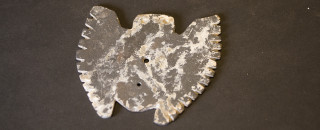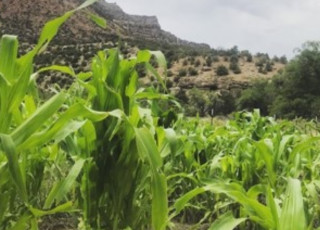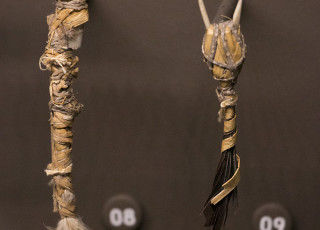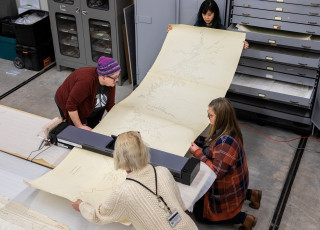Objects Tell Stories of the Fremont People
Owl Pendent discovered at Baker Village. Photo © NHMU.
By Westin Porter
Objects are the best storytellers. They can be simple and subtle, yet captivating and cryptic. They embody ideas, significance, and context; as they are found, or created, traded, stolen, borrowed, and broken, they become the currency of culture. It’s why we call them vessels: they transport meaning. When studying people, particularly through hundreds and thousands of years of time and sediment, it is their objects that survive to tell their stories.
In the case of the Fremont, the indigenous people that inhabited much of what is now Utah for over half a millennium, those stories have been preserved at sites like Baker Village, a Fremont settlement near the present-day Utah-Nevada border. The stories are sherds of pots, baskets, moccasins, stones, shells, buildings, and more. And sites like Baker Village have been keeping those stories, waiting for them to be told.

The Fremont lived across the Great Basin and Colorado Plateau from roughly 650 CE to 1350 CE. They were prehistoric horticulturists, who both hunted and gathered as well as farmed. While their Ancestral Puebloan counterparts to the south gathered and lived in relatively larger communities like Keet Seel and Betatakin, the Fremont were less sedentary and tended to live in smaller communities. However, as populations grew and technologies advanced, they became more sedentary. According to BYU anthropologist Rich Talbot, it was around 900 CE that the Fremont began gathering in larger communities.
It was at these sites, villages of several hundred, that the Fremont would gather for ceremonies. People travelled from across the region to gather and celebrate. They gambled, feasted, gave gifts, and traded. Fortunately for anthropologists like Talbot, they left a lot behind.
“People were going there to trade and they wanted to come out ahead, trading what they had for something that they needed, but there’s obviously much more going on,” says Talbot. “It’s a social event. It’s renewing of relationships, it’s establishing ties with people you want to have ties with, including familial ties. It’s a social event that would be anticipated and looked forward to and planned for.”
Talbot has studied the Fremont for much of his career, and from 1991-1994 he worked with his predecessor, Dr. Jim Wilde and the BYU Archaeology Field School, to excavate one of the most revealing and mystifying Fremont sites discovered to date: Baker Village.
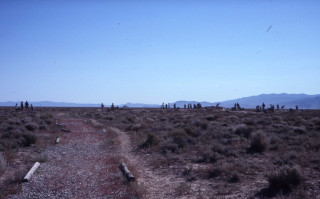
Situated on the western edge of Fremont territory, what is now the Utah-Nevada border, Baker Village housed several hundred Fremont from roughly 1000 – 1300 CE.
“In Fremont land you get various sized sites,” explains Talbot. “A good share of the people live just in little farmsteads or hamlets of one, two, or three pithouses, and then you get some of the larger villages that housed as many as 400 or 500 people.”
Baker Village is somewhere in between. It is the largest village discovered to date in the western region of Fremont land, however, with its seven pithouses (think town hall meets mess hall), Baker Village is considered medium sized in relation to those more densely populated villages found in the heartland of Fremont territory. Researchers are unsure of its exact size, however, as much of the village has been plowed over and destroyed as it rests on what is now private land.
“The Fremont congregated in good areas for farming, and that’s exactly the situation where Baker is,” says Talbot. “You’ve got Baker Creek coming down out of the mountains, which would have provided adequate water for a fairly sized population.”
But aside from its significant size and peculiar location, Baker Village reveals key insights into Fremont life that make it unique.
In his extensive excavation and study of the site, Talbot and his team discovered items normally found at Fremont sites such as ceramic ware and granaries, but they also discovered exotic items like sea shells and turquoise. These goods would have been harvested as far as hundreds of miles from their final destination at Baker, and are evidence of complex and broad trade networks that suggest more nuanced political structures than ever before understood.
Trade is an indicator of socio-political contexts as much as it is of sheer economics, and sites like Baker Village—social and political hubs, akin to modern cities—provide the most complete record of who was trading what and why.

“Politics are a tricky one,” says Talbot. “They don’t show up in the archaeological record very easily. But from what we’ve seen, what happens when these villages get larger is that people tend to want to acquire power. Just like today, people are drawn to the big city because there are things happening there. There are people who are seeking prestige and to become better or have more power than their neighbors.”
Exchange of goods is a social performance brimming with social and political motivations. Like any culture, the Fremont were deeply engaged in complicated and nuanced societal construction defined by power. Vestiges of these political structures can also be found in the actual, physical structures found at Baker Village. Talbot and other researchers determined that the buildings at Baker were arranged to mark the winter and summer solstices. Hints of this kind of advanced urban planning around astronomical alignment are present at other Fremont sites, but none as clearly as Baker.
These complexities are socio-political indicators, Talbot says, that tell us that somebody there is calling the shots. Somebody with a deep understanding of the world around them and the people they live with.
“It’s hazy, it’s always hazy, to understand the socio-political,” says Talbot. “But it’s really the heart of Fremont life. It’s what goes on in people’s lives every single day. Besides the economics of what are we going to eat today?, it’s who am I going to talk to today, who am I going to deal with today?”
Westin Porter is a Digital Science Writer for the Natural History Museum of Utah, a part of the University of Utah in Salt Lake City. Our mission is to illuminate the natural world and the place of humans within it. In addition to housing outstanding exhibits for the public, NHMU is a research museum. Learn more.
